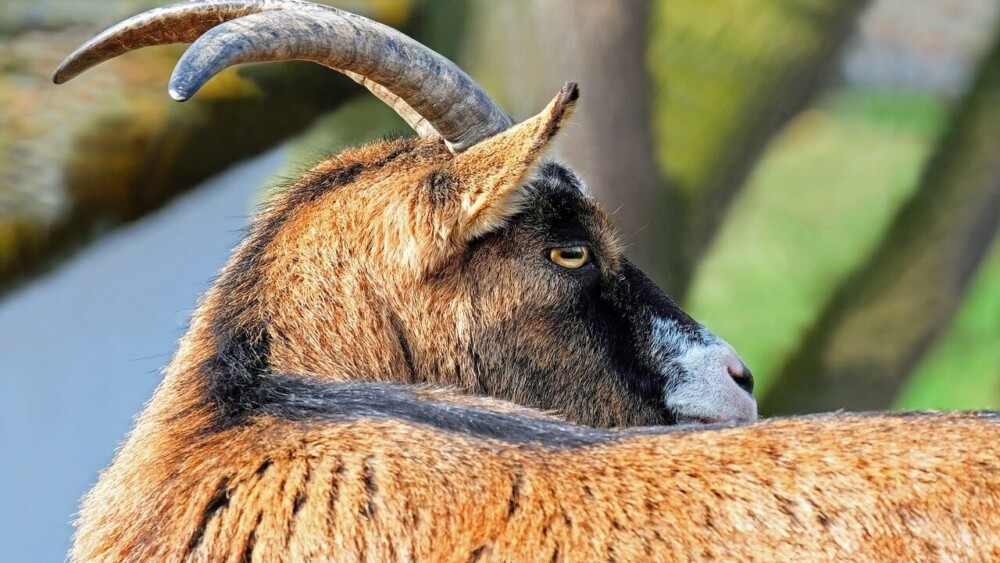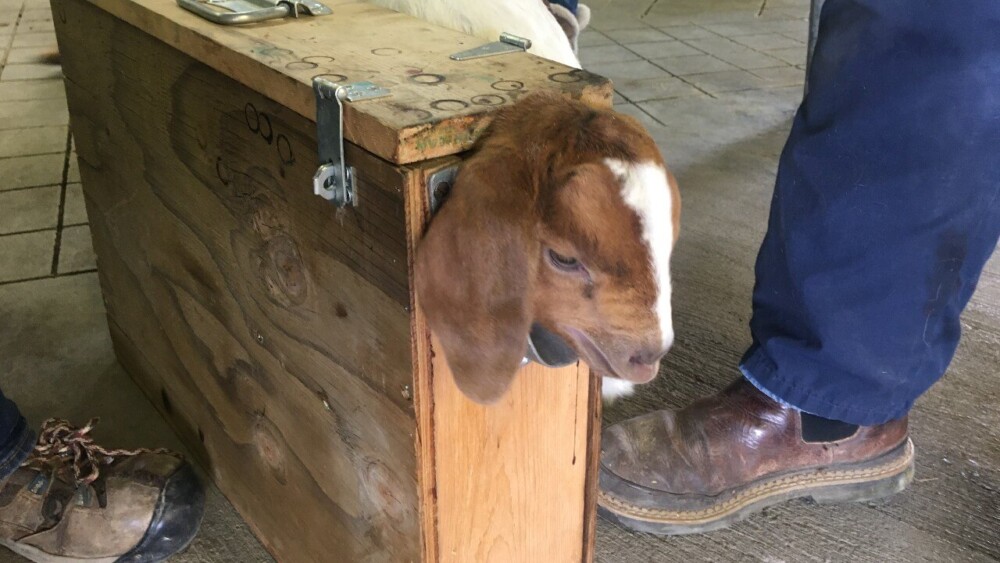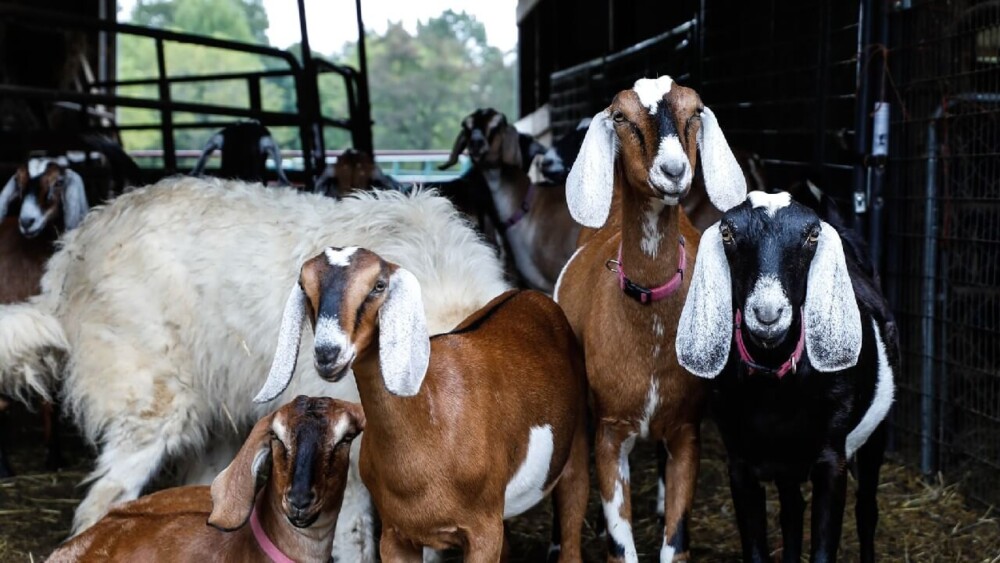
Goats can get into all sorts of trouble and even more so if they have horns. Getting their horns stuck in fencing is common. They can also accidentally stab you with their horns when you are working around them. As a result of these risks, many goat owners are searching for hornless goats.
Are there hornless goats? There are many breeds of goats that are born naturally hornless. These animals are called “polled” and carry a unique genetic marker. This allows them to also produce hornless kids in at least 50% of their offspring.
Polled goats are identical to the rest of their breed, except they have one difference in their genetics to cause the hornlessness. Additionally, polled goats can be bred to other polled goats or to horned goats. This produces more naturally hornless goats.
Disbudded goats are goats whose horns were prevented from growing when they were very little. Disbudding usually occurs around 1-2 weeks. The process of disbudding can be done through cauterization or chemical “cauterization.”
Dehorned goats are goats whose horns grow and need to be removed after growth. Dehorning removes horns that are already significantly grown. It is a more entailed process and carries a higher risk to the goat.
There are a lot of things to understand about these three types of hornless goats. Let’s get started.

Why Do Goats Have Horns?
Goats are part of the Bovidae family, which includes antelope, wildebeest, sheep, and cattle. In the wild, these animals have the ability to naturally grow horns. After sheep, goats, and cattle were domesticated and selectively bred, hornless offspring started to showing up. As genetic anomalies, they should have horns, but they were born completely lacking the horned gene.
Horns on goats can serve many purposes. Heat dissipation is probably one of the most important reasons goats have horns. The horns contain rich blood supply. It makes goats regulate their body temperatures more easily from dissipating heat from the surface of the horns.
Additionally, goats can use their horns for protection from predators as well as a way to fight with other males for breeding rights. If you plan on keeping your goats in a large pasture and not checking on them on a daily basis, having horns can protect them from coyotes, stray dogs, and other threats.

Genetics of Polled Goats
Polled goats are naturally hornless. In some capacities, polled goats are intentionally bread because of their preference. Polled goats are especially preferred in the Dairy goat market. Other goat breeders are suspicious of polled goats because of unsubstantiated claims that polled goats are less fertile.
Will the Offspring of a Polled Goat Also be Polled? A polled doe to a polled buck will produce polled offspring since the polled gene is dominant (like blue eyes).
While a homozygous horned goat cannot produce polled kids unless the mate is polled, heterozygous polled goats can create both polled and horned, and homozygous goats can’t create horned offspring at all.
Think of it this way:
HH = Homozygous horned, and cannot produce polled kids.
PH = Heterozygous polled, and can create both horned and polled.
PP = Homozygous polled, and can only produce polled kids, with zero possibility of horned offspring.
So, let’s apply that:
Let’s imagine you own three bucks and three does. Brandy and Bramble are homozygous horned (pp), while Sugar and Joe are heterozygous polled (Pp), and Butch and Briar are homozygous polled (PP).
Here’s a graph showing the average percentages of their polled/horned offspring on a long-term basis (NOT per year):
| Parents | Percentage of Homozygous Horned (pp) | Percentage of Heterozygous Polled (Pp) | Percentage of Homozygous Polled (PP) |
| Brandy (pp) + Bramble (pp) | 100% | 0% | 0% |
| Brandy (pp) + Sugar (Pp) | 50% | 50% | 0% |
| Brandy (pp) + Briar (PP) | 0% | 0% | 100% |
| Butch (PP) + Bramble (pp) | 0% | 100% | 0% |
| Butch (PP) + Sugar (Pp) | 0% | 50% | 50% |
| Butch (PP) + Briar (PP) | 0% | 0% | 100% |
| Joe (Pp) + Sugar (Pp) | 25% | 50% | 25% |
You might wonder why polled goats aren’t more popular. This is due to an increased likelihood of sterile hermaphrodites. Modern breeders have mixed opinions on this, since technically, horned and polled goats can each produce a hermaphrodite, and some even argue that there is no statistical evidence supporting this viewpoint.
That said, it’s supposed to be more likely if a homozygous polled buck is bred to a homozygous polled doe, like Butch and Briar in our example above. The chance is a bit reduced if a horned goat is bred to a polled goat, like Brandy and Sugar.
Hopefully, the genetics seem a bit less murky now. But what if you raised a horned kid, and you need to know about removing the horns?

Reasons Breeders Choose Hornless Goats
Having hornless goats is much more appealing in dairy breeds than meat breeds or those kept on large pastures. For dairy breeds, the goats will likely be entering a milking parlor and placing their heads in a stanchion for milking. Horns can get caught on the stanchion or prevent the goat from placing their head in it entirely.
Goats kept around children or used for junior livestock shows, such as 4H, dehorned or naturally hornless breeds are used almost exclusively to prevent any accidental injuries to the children handling them.
Additionally, shows for dairy breeds almost always require the show goats to be hornless either from natural genetics or disbudding. Breeding goats are usually shown with horns, but polled animals in meat breeds are common simply due to the safety of handling.
- Show and exhibition rules often require hornless goats
- Dairy goats are often disbudded if they aren’t polled
- Some owners prefer hornless so the goats don’t get tangled in fencing
What is Disbudding?
Breeders often name disbudding as the worst part of breeding and raising goats. Disbudding is the physical removal of the horn bud on a very young goat. It is almost always done on goats less than 14 days of age, usually around day 4 or 5.
The process is mostly done on dairy goats, especially if they will be entering milking stations. You can disbudd any goat breed.
The process of disbudding requires the use of an electric dehorning tool. The dehorner has a metal or ceramic cup on the end that reaches temperatures of up to 1,300 degrees Fahrenheit (704 Celsius). It is placed on the head of the goat, directly over the tiny bumps where the horns are just starting to grow in. The dehorner cauterizes the blood supply that normally feeds the horns, preventing the growth of the horns as the goat matures.

Disbudding is a controversial subject for many goat keepers. It is briefly painful and stressful for the goat kid to endure. It’s done while the goat is fully conscious and awake. Kids usually start acting normal again within minutes of disbudding
Some topical pain medications or nerve blockers are available. But according to the Animal and Plant Health Inspection Service (APHIS), in the United States, only 30% of commercial operations use them. There are also risks to the young goat, especially if the person doing the disbudding is inexperienced.
It is absolutely crucial that an experienced handler or veterinarian burns the horn buds. If you’ve never done it before, please have someone more experienced show you several times before you attempt it.
Dehorning
While often used interchangeably, disbudding and dehorning are actually different processes used to remove a goat’s horns.
Disbudding refers to cauterizing the buds within the first two weeks of life, before they’ve attached to the frontal bone of the skull, which happens approximately at two months of age.
Dehorning, on the other hand, is a much involved and messier practice that involves cutting off horns that have already grown. It usually involves a saw and a vet putting the goat under anesthesia.
One of our kids, named Muppet, experienced both botched cauterization and dehorning before we adopted him. His horns grew inward, which is called “suicide horns. ” These spurs can chaff his cheeks. We had remove them with another process, or they would’ve kept growing into his face.
As you can see, particular care is essential when dealing with horns. Use extreme caution, and be humane.

Horn Removal with Other Methods
Other methods are available to stop the future growth of horns. Caustic paste and bands are becoming more popular tools. The caustic paste follows the same idea as the disbudding iron. It cauterizes the blood vessels to prevent the horn from continuing to grow.
Caustic paste uses chemicals instead of high temperatures to cauterize. Caustic paste is made for very young goats, like an electric disbudding tool. But, don’t use it on goats kept in large groups of other goats. The caustic paste can rub onto another goat’s head or body. Then, chemical burns and other injuries can happen.
Banding is a process that is used on mature goats that already have their horns grown. Banding stops the existing blood flow to the horn so the tissue dies and the horn falls off. This process takes a month, or more, depending on the horn size. Some people say it is a continuously painful or uncomfortable sensation for the goat.
Additionally, an improperly placed band can cause bruising on the delicate tissue near the base of the horn. In some cases it causes scars or unsightly fragments of horn left behind.
To Disbud or Not
The question of disbuding your goats, or not, is a very controversial question. I have seen both sides of the issue. We raise goats with horns and disbudded goats. We don’t disbud our boar goats. I have found that after the first week, our goats figured out how to get out of the fence when they got stuck.
But, every year, my kids also participate in the local 4H and show market goats. One of the requirements is that the goats are disbudded or dehorned. Usually, disbudding is not an issue. But, one year, ;my daughter purchased a horned kid “Smokey” for 4H. We had to dishorn it.
Our vet is very knowledgeable. He dishorned Smokey without any complications. But, it was much more involved and it took Smokey a couple of days he acted normal again. Personally, I would avoid dehorning as much as possible unless it interfered with the health or safety of the goat or a person. It’s a hard process to witness.
Regardless of whether you are adamantly pro-disbudding goats, or adamantly against it, let’s practice a little grace and kindness to those who sit on the other side of the issue.

My Essential Goat Supplies
This list contains affiliate products. Affiliate products do not cost more but helps to support BestFarmAnimals and our goal to provide farm animal owners with accurate and helpful information.
This little giant bucket fits on a fence and this one’s easy to carry.
A sturdy dog collar is essential. Don’t do rope (they’ll break and tangle) or chain (injury!).
A Black Water Tub is way nicer than buckets that tip over. I like to get a 20 or 30-gallon in each pen so my goats have plenty of water, but you can get 100-gallons if you have a lot of sheep in one pen.
Loose minerals in a small bag or a Purina 50 lb bag, and a mineral feeder for free-choice is the best option. One side holds minerals, and the other holds baking soda. Don’t feed sheep goat minerals because it usually contains copper- something that is fatal to sheep.
Hoof trimmers are a necessity because you’ll need to trim your sheep’s hooves every few months. These are nice for the price.
Don’t make the mistake I made by waiting to order a drench gun before you need it. I was surprised by how often I use it. It helps with bloating, dehydration, and other ailments. Here’s a good drench, but you can also drench a bloat solution or water if dehydrated.
Digital Thermometor for when your lambs act sick. You’ll need to know if their temps are too low or too high so you can accurately diagnose the issues.
Vetericyn for wound care. It makes a big difference in a speedy recovery.
Check out this list of goat milk supplies you need if you have milk goats.

